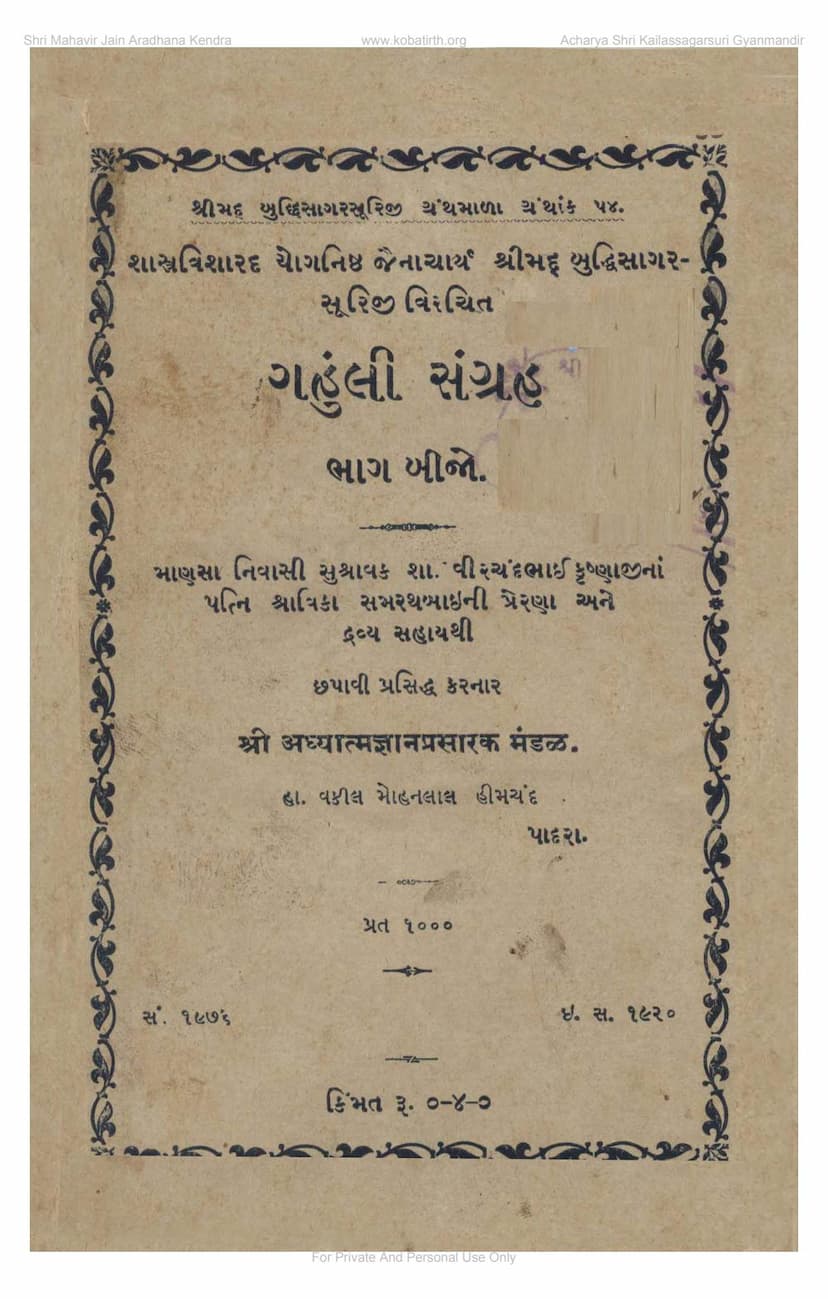Gahuli Sangraha Part 2
Added to library: September 1, 2025

Summary
Here's a comprehensive summary of "Gahuli Sangraha Part 2" by Buddhisagar, based on the provided text:
Book Title: Gahuli Sangraha Part 2 (ગહલી સંગ્રહ ભાગ બીજો) Author: Acharya Shrimad Buddhisagar Suriji Publisher: Shri Adhyatma Gyan Prasarak Mandal Publication Year: 1920 CE (Samvat 1976) Context: This is the second part of a collection of "Gahuli," which are devotional songs or hymns composed in vernacular Gujarati, often set to popular tunes for accessibility and emotional resonance.
Overall Purpose and Content:
"Gahuli Sangraha Part 2" is a collection of 115 devotional songs (Gahuli) composed by Acharya Buddhisagar Suriji. These songs are primarily spiritual in nature and aim to inspire devotion, reinforce Jain principles, and offer guidance for spiritual practice. The themes cover a wide range, including:
- Praise of Gurus and Acharyas: Many songs are dedicated to praising respected Jain gurus and acharyas, highlighting their virtues and contributions to the faith. This includes hymns dedicated to Acharya Ravishagarji, Sukh Sagarji, Atmaramji, Vriddhichandji, Mohanlalji, Vijaylakshmi Suri, Abhayadev Suri, Anandghanji, Jintatt Suri, Manivijayji, and others.
- Adoration of Lord Mahavir: A significant portion of the collection focuses on glorifying Lord Mahavir, his life, teachings, and spiritual significance. This includes hymns on his birth, childhood, renunciation, teachings, and divine nature.
- Jain Principles and Practices: The songs expound on core Jain tenets such as the importance of the right faith (Samyak Darshan), knowledge (Jnana), conduct (Charitra), and penance (Tapa). They also touch upon ethical conduct, abstaining from vices, and the universal nature of Jain Dharma.
- Devotional and Spiritual Experiences: Several Gahulis express deep spiritual devotion and an aspiration for self-realization and liberation (Moksha). They often describe the experience of divine presence and the longing for spiritual union.
- Social and Ethical Guidance: Some songs offer advice on social reforms, condemning harmful practices and promoting virtuous living. They also provide guidance for householders, particularly women (Shravikas), on maintaining family harmony and spiritual practice.
- Specific Jain Festivals and Observances: Hymns are included for occasions like Ouali (a period of fasting and devotion), Diwali, Gyan Panchami, and the commemoration of Mahavir Swami's birth anniversary.
- Philosophical Concepts (Naya): The preface mentions the inclusion of songs that explore philosophical concepts like Naya (modes of predications) and the notion of Mahavir as a universal form, emphasizing the non-absolutist nature of Jain philosophy (Syadvada).
Key Features and Themes Elaborated:
- Accessibility: The use of popular tunes and vernacular language (Gujarati) makes these spiritual themes accessible to a broad audience, fostering emotional connection and engagement.
- Emphasis on Devotion (Bhakti): The collection strongly emphasizes the power of devotion to Lord Mahavir and to the spiritual preceptors.
- Moral and Ethical Instruction: The songs serve as a means of moral instruction, guiding devotees towards righteous living and discouraging negative traits and actions.
- Holistic Approach: The work encompasses praise for spiritual leaders, teachings about Jain philosophy, calls for social reform, and devotional songs for festivals, offering a holistic approach to spiritual life.
- Context of Publication: The book was published in 1920 CE, reflecting the spiritual and cultural milieu of the time, with support from patrons like Shah Vithalchandbhai Krishnaji and his wife Samarthbai from Manasa.
Structure:
The book is organized into a comprehensive index (Vishayanukramanika) listing the 115 Gahulis by title, covering a diverse range of subjects and spiritual invocations. The text includes devotional songs, prayers, and teachings, often presented with the tune or rhythm indicated for singing.
Significance:
"Gahuli Sangraha Part 2" stands as a valuable spiritual resource within the Jain tradition, offering a collection of devotional songs that have likely been cherished by devotees for their melodious expression of faith, philosophical insights, and moral guidance. It reflects the commitment of Acharya Buddhisagar Suriji to spread Jain teachings through accessible and emotionally engaging art forms.